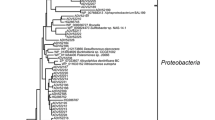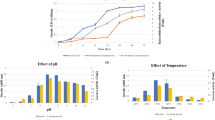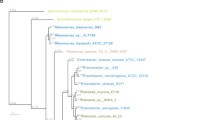Abstract
We describe the isolation and characteristics of a novel thermophilic bacterium from soil. The organism is a member of the Anoxybacillus genus based on phylogenetic analysis of the 16S rRNA gene. The 16S rRNA of the organism shares >99% sequence identity with those of two species, Anoxybacillus rupiensis and A. geothermalis. We named this isolate as Anoxybacillus sp. strain UARK-01. UARK-01 grows optimally in the presence of oxygen at 55 °C and pH 8. It grew excellently in the presence of lignin as the sole carbon source. Culture supernatant from UARK-01 grown on lignin was rich in laccase activity. The laccase activity was optimal at 90 °C and pH 9, and there was comparable activity at 80 and 100 °C. The crude laccase decolorized approximately 75% of Congo Red in 7 h under optimal conditions. A single laccase gene was identified from the draft genome sequence of Anoxybacillus sp. UARK-01. The UARK-01 laccase (Anox_Lacc) was cloned and overexpressed in Escherichia coli and was partially purified. The partially purified Anox_Lacc decolorized approximately 1.64+/0.21 nanomoles of Congo Red per microgram protein in 30 min at 90 °C and pH 9. Anox_Lacc is a member of the multicopper polyphenol oxidoreductase laccase family (pfam02578 Cu-oxidase_4) and has novel characteristics. Multiple sequence analysis of Anox_Lacc with six homologs from the family revealed four conserved copper ligands and several new residues that are fully conserved. Anox_Lacc is enriched in leucine, glutamine, and lysine, and it contains fewer alanine, arginine, glycine, and serine residues. Skewed amino acid composition of Anox_Lacc likely contributes to the exceptional thermochemical properties of the laccase activity from UARK-01. Both lignin utilization and production of hyperthermostable alkaline laccase are new findings in the Anoxybacillus genus.






Similar content being viewed by others
References
Altschul SF, Gish W, Miller W, Myers EW, Lipman DJ (1990) Basic local alignment search tool. J Mol Biol 215:403–410
Chai YY, Kahar UM, Md Salleh M, Md Illias R, Goh KM (2012) Isolation and characterization of pullulan-degrading Anoxybacillus species isolated from Malaysian hot springs. Environ Technol 33(10–12):1231–1238
Cihan AC, Ozcan B, Cokmus C (2011) Anoxybacillus salavatliensis sp. nov., an α-glucosidase producing, thermophilic bacterium isolated from Salavatli, Turkey. J Basic Microbiol 51(2):136–146
Coorevits A, Dinsdale AE, Halket G, Lebbe L, De Vos P, Van Landschoot A, Logan NA (2012) Taxonomic revision of the genus Geobacillus: emendation of Geobacillus, G. stearothermophilus, G. jurassicus, G. toebii, G. thermodenitrificans and G. thermoglucosidans (nom. corrig., formerly ‘thermoglucosidasius’); transfer of Bacillus thermantarcticus to the genus as G. thermantarcticus comb. nov.; proposal of Caldibacillus debilis gen. nov., comb. nov.; transfer of G. tepidamans to Anoxybacillus as A. tepidamans comb. nov.; and proposal of Anoxybacillus caldiproteolyticus sp. nov. Int J Syst Evol Microbiol 62(Pt 7):1470–1485
De Clerck E, Rodriguez-Diaz M, Vanhoutte T, Heyrman J, Logan NA, De Vos P (2004) Anoxybacillus contaminans sp. nov. and Bacillus gelatini sp. nov., isolated from contaminated gelatin batches. Int J Syst Evol Microbiol 54(Pt 3):941–946
Deep K, Poddar A, Das SK (2013) Anoxybacillus suryakundensis sp. nov, a moderately thermophilic, alkalitolerant bacterium isolated from hot spring at Jharkhand, India. PLoS ONE 8(12):e85493
Derekova A, Sjoholm C, Mandeva R, Kambourova M (2007) Anoxybacillus rupiensis sp. nov., a novel thermophilic bacterium isolated from Rupi basin (Bulgaria). Extremophiles 11(4):577–583
Dulger S, Demirbag Z, Belduz AO (2004) Anoxybacillus ayderensis sp. nov. and Anoxybacillus kestanbolensis sp. nov. Int J Syst Evol Microbiol 54(Pt 5):1499–1503
Edgar RC (2004) MUSCLE: multiple sequence alignment with high accuracy and high throughput. Nucleic Acids Res 32(5):1792–1797
Eggert C, Temp U, Eriksson KE (1997) Laccase is essential for lignin degradation by the white-rot fungus Pycnoporus cinnabarinus. FEBS Lett 407(1):89–92
Eloqua A, Pita M, Polaina J, Martinez-Arias A, Golyshina OV, Zumarraga M, Yakimov MM, Garcia-Arellano H, Alcalde M, Fernandez VM, Elborough K, Andreu JM, Ballesteros A, Plou FJ, Timmis KN, Ferrer M, Golyshin PN (2006) Novel polyphenol oxidase mined from a metagenome expression library of bovine rumen: biochemical properties, structural analysis, and phylogenetic relationships. J Biol Chem 281(32):22933–22942
Filippidou S, Jaussi M, Junier T, Wunderlin T, Jeanneret N, Palmieri F, Palmieri I, Roussel-Delif L, Vieth-Hillebrand A, Vetter A, Chain PS, Regenspurg S, Junier P (2016) Anoxybacillus geothermalis sp. nov., a facultative anaerobic endospore-forming bacterium isolated from mineral deposits in a geothermal station. Int J Syst Evol Microbiol 66(8):2944–2951
Galai S, Limam F, Marzouki MN (2009) A new Stenotrophomonas maltophilia strain producing laccase. Use in decolorization of synthetics dyes. Appl Biochem Biotechnol 158(2):416–431
Galkiewicz JP, Kellogg CA (2008) Cross-kingdom amplification using bacteria-specific primers: complications for studies of coral microbial ecology. Appl Environ Microbiol 74(24):7828–7831
Goh KM, Kahar UM, Chai YY, Chong CS, Chai KP, Ranjani V, Illias R, Chan KG (2013) Recent discoveries and applications of Anoxybacillus. Appl Microbiol Biotechnol 97(4):1475–1488
Hilden K, Hakala TK, Lundell T (2009) Thermotolerant and thermostable laccases. Biotechnol Lett 31(8):1117–1128
Jeon JR, Baldrian P, Murugesan K, Chang YS. (2012) Laccase-catalysed oxidations of naturally occurring phenols: from in vivo biosynthetic pathways to green synthetic applications. Microb Biotechnol 5(3):318–332
Ko JK, Um Y, Park YC, Seo JH, Kim KH (2015) Compounds inhibiting the bioconversion of hydrothermally pretreated lignocellulose. Appl Microbiol Biotechnol 99(10):4201–4212
Kudanga T, Le Roes-Hill M (2014) Laccase applications in biofuels production: current status and future prospects. Appl Microbiol Biotechnol 98(15):6525–6542
Larkin MA, Blackshields G, Brown NP, Chenna R, McGettigan PA, McWilliam H, Valentin F, Wallace IM, Wilm A, Lopez R, Thompson JD, Gibson TJ, Higgins DG (2007) Clustal W and Clustal X version 2.0. Bioinformatics 23:2947–2948
Lee SJ, Lee YJ, Ryu N, Park S, Jeong H, Lee SJ, Kim BC, Lee DW, Lee HS (2012) Draft genome sequence of the thermophilic bacterium Anoxybacillus kamchatkensis G10. J Bacteriol 194(23):6684–6685
Margeot A, Hahn-Hagerdal B, Edlund M, Slade R, Monot F (2009) New improvements for lignocellulosic ethanol. Curr Opin Biotechnol 20(3):372–380
Namsaraev ZB, Babasanova OB, Dunaevsky YE, Akimov VN, Barkhutova DD, Gorlenko VM, Namsaraev BB (2010) Anoxybacillus mongoliensis sp. nov., a novel thermophilic proteinase producing bacterium isolated from alkaline hot spring, central Mongolia. Mikrobiologiia 79(4):516–523
Pikuta E, Lysenko A, Chuvilskaya N, Mendrock U, Hippe H, Suzina N, Nikitin D, Osipov G, Laurinavichius K (2000) Anoxybacillus pushchinensis gen. nov., sp. nov., a novel anaerobic, alkaliphilic, moderately thermophilic bacterium from manure, and description of Anoxybacillus flavitherms comb. nov. Int J Syst Evol Microbiol 50(Pt6):2109–2117
Piscitelli A, Pezzella C, Giardina P, Faraco V, Giovanni S. (2010) Heterologous laccase production and its role in industrial applications. Bioeng Bugs. 1(4):252–262
Poli A, Esposito E, Lama L, Orlando P, Nicolaus G, de Appolonia F, Gambacorta A, Nicolaus B (2006) Anoxybacillus amylolyticus sp. nov., a thermophilic amylase producing bacterium isolated from Mount Rittmann (Antarctica). Syst Appl Microbiol 29(4):300–307
Poli A, Romano I, Cordella P, Orlando P, Nicolaus B, Ceschi Berrini C (2009) Anoxybacillus thermarum sp. nov., a novel thermophilic bacterium isolated from thermal mud in Euganean hot springs, Abano Terme, Italy. Extremophiles 13(6):867–874
Rodriguez Couto S, Toca Herrera JL (2006) Industrial and biotechnological applications of laccases: a review. Biotechnol Adv 24(5):500–513
Saw JH, Mountain BW, Feng L, Omelchenko MV, Hou S, Saito JA, Stott MB, Li D, Zhao G, Wu J, Galperin MY, Koonin EV, Makarova KS, Wolf YI, Rigden DJ, Dunfield PF, Wang L, Alam M (2008) Encapsulated in silica: genome, proteome and physiology of the thermophilic bacterium Anoxybacillus flavithermus WK1. Genome Biol 9(11):R161
Stamatakis A (2014) RAxML version 8: a tool for phylogenetic analysis and post-analysis of large phylogenies. Bioinformatics 30(9):1312–1313
Wang J, Feng J, Jia W, Chang S, Li S, Li Y. (2015) Lignin engineering through laccase modification: a promising field for energy plant improvement. Biotechnol Biofuels 8:145
Yanmis D, Adiguzel A, Nadaroglu H, Gulluce M, Demir N (2016) Purification and characterization of laccase from thermophilic Anoxybacillus gonensis P39 and its application of removal textile dyes. Romanian. Biotechnol Lett 21(3):11485–11496
Yumoto I, Hirota K, Kawahara T, Nodasaka Y, Okuyama H, Matsuyama H, Yokota Y, Nakajima K, Hoshino T (2004) Anoxybacillus voinovskiensis sp. nov., a moderately thermophilic bacterium from a hot spring in Kamchatka. Int J Syst Evol Microbiol 54(Pt 4):1239–1242
Zhang CM, Huang XW, Pan WZ, Zhang J, Wei KB, Klenk HP, Tang SK, Li WJ, Zhang KQ (2011) Anoxybacillus tengchongensis sp. nov. and Anoxybacillus eryuanensis sp. nov., facultatively anaerobic, alkalitolerant bacteria from hot springs. Int J Syst Evol Microbiol 61(Pt 1):118–122
Zille A, Tzanov T, Gubitz GM, Cavaco-Paulo A (2003) Immobilized laccase for decolourization of Reactive Black 5 dyeing effluent. Biotechnol Lett 25(17):1473–1477
Acknowledgements
This research was supported by startup funds provided to RDB by the University of Arkansas. We thank Prof. Julie Carrier for providing the switchgrass. THAA acknowledges stipend support from Prince Sattam University. Undergraduate students, AS and TC, acknowledge support from the National Science Foundation Research Experience for Undergraduates program through the University of Arkansas REU Site (DBI-1063067).
Author information
Authors and Affiliations
Corresponding author
Ethics declarations
Conflict of interest
None.
Additional information
The 16S and laccase gene sequences from the Anoxybacillus sp. strain UARK-01 have been deposited in GenBank under the accession numbers KX784766 and KY679089, respectively.
Electronic supplementary material
Below is the link to the electronic supplementary material.
Rights and permissions
About this article
Cite this article
Al-kahem Al-balawi, T.H., Wood, A.L., Solis, A. et al. Anoxybacillus sp. Strain UARK-01, a New Thermophilic Soil Bacterium with Hyperthermostable Alkaline Laccase Activity. Curr Microbiol 74, 762–771 (2017). https://doi.org/10.1007/s00284-017-1239-5
Received:
Accepted:
Published:
Issue Date:
DOI: https://doi.org/10.1007/s00284-017-1239-5




